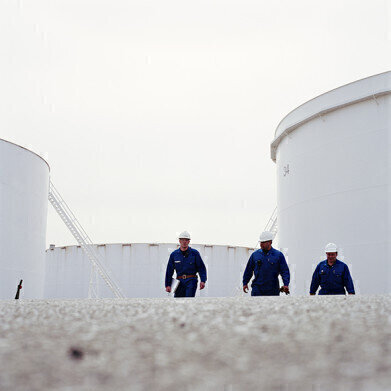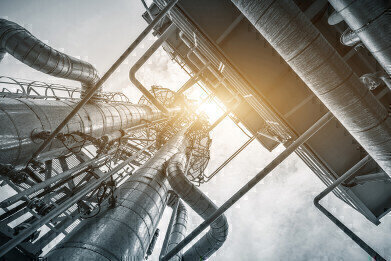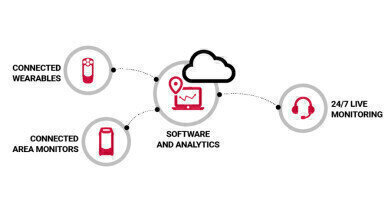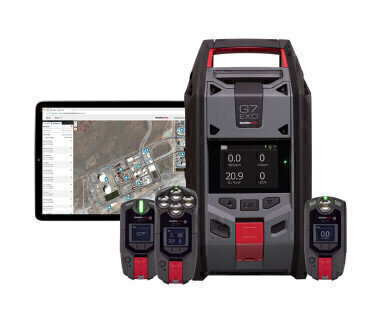Gas Detection
Proactively reducing the levels of risk to personnel at oil and gas facilities with connected safety
Jul 18 2022
Every part of the oil and gas production process requires precise and real-time monitoring of safety parameters to protect workers and assets. Thanks to digital transformation and IoT, connected safety solutions have taken this procedure from being reactive, yet legally compliant, in cases of hazardous situations to proactively preventing situations from occurring thus reducing the dangers to both people and facilities.
What is a connected safety solution?
Blackline Safety provide connected safety solutions that are made up of a network of cloud-connected devices, which includes area monitors and personal wearable instruments that, when connected to an online dashboard, offer a full overview of the safety of assets and workers at the plant. The information streamed from the devices provide extensive and easy-to-access reporting capabilities to safety managers, including real-time compliance status – ensuring that bump and calibrations are carried out for the while network of devices and that the instruments are charged, activated and being used throughout a shift. This data can be watched from anywhere in real-time with no need to wait for a device to be docked to receive the information. Additional data analysis enables identification and prediction of possible hazards so the necessary steps can be taken to avert an incident occurring.
How do connected safety solutions reduce risks to facilities and workers?
It is easiest to explain connected safety by providing real examples, so a few examples of risks commonly encountered in the oil/gas sector that can be diminished by using Blackline’s safety solutions.
Workers in the oil and gas industry often operate alone or in remote areas, in upstream and midstream locations, where personnel often move around a variety of locations during their shift, as well as in downstream facilities where workers are often out of sight and sound from their colleagues. There are many different hazards lone or remote workers encounter, such as accidents while traveling, exposure to toxic or explosive gas, health problems, falls, bad weather conditions or even wildlife.
Using wearable instruments with sensors and functionality to automatically detect falls, lack of movement or missed check-ins, could potentially save lives. Lone workers can also send an SOS alert to connect them immediately to their safety monitoring team if they need assistance. If toxic or flammable gases pose a potential risk during their shift, Blackline’s versatile lone worker devices can be configured, or reconfigured, to incorporate single- or multi-gas detection capabilities. Having real-time knowledge of their personnel gives peace-of-mind to safety management who can rest easy in the knowledge that their people are being monitored on an ongoing, uninterrupted basis should any incidents occur.
According to the CDC (Center for Disease Control and Prevention): the fatality rate in the oil and gas sector is seven times higher than the fatality rate of US workers in general. Clearly an improvement in how we protect workers in this industry is needed – and prevention is better than cure!
Continuous, real-time gas monitoring.
Connected safety solutions monitor levels of gas continuously in real-time: therefore, they can recognise possibly hazardous levels before an incident occurs causing harm to workers and damage to assets. Confined space entries (CSE) are a ideal case in point; these areas are particularly hazardous as gases can concentrate rapidly to reach dangerous levels or displace oxygen in locations with poor ventilation.
Blackline Safety's G7 EXO Area Monitor or G7c Multi-gas Pump Detector are connected instruments that ensure that such areas are safe for personnel before they enter, they also alert them to evacuate if gas levels exceed safe thresholds whilst they are in the CSE. Thanks to its extended battery life of 100+ days, the EXO enables extended CSEs without the need to re-permit.
Continuous monitoring allows operators to identify gas leaks early thus avoiding catastrophic events. As an example, around-the-clock area gas monitoring can inform the users when a piece of equipment is gradually releasing a great volume of vapours into an area, alerting the user of the need to repair or replace the item. As the instruments are continuously connected, data can be observed in real-time through the Blackline Live online dashboard.
Streamlining evacuation management at hydrocarbon processing plants
Oil and gas production is littered with potential hazards. Storage tanks, production apparatus, surface equipment are among the many potential sources of flammable gases that can cause fires and explosions, while toxic gases, for example: hydrogen sulphide, are also ubiquitous and cause for possible evacuations. Opting for a connected safety solution could mean the difference between preventing an incident or having to react to the incident.
Using a system that continuously monitors for heightened levels of hazardous gases enables a rapid evacuation of personnel and enables the safety team to make sure that nobody is left behind. Connected safety systems allow the safety management team to account for every person onsite as they make their way to the muster points. The Blackline Live portal enables the safety team to know where all their personnel are, so they can send help to anyone who needs it – rather than finding out that somebody is missing after a headcount and then having to search the facility. This saves precious time and the necessity to send a search party into hazardous areas in the hope of finding their colleague. In addition, the data from the devices will inform rescue crews about the conditions in which the team member is located, whether they need to worry about high levels of gas etc. – and if the person is moving or has fallen.
Other, harder to recognise risks may also occur in plants and refineries that can cause injury, damage and the associated downtime and financial costs. Blackline’s connected safety systems provides data that will warn of such potential hazards. For example, if there are several incidents of personnel falling over in the same location, it will indicate this to the operator. The hazard may be brought about by a slippery surface caused by ice, or a leak, so the system will alert the team that a pattern of problems is occurring at a specific location so preventative action can be taken to avert further incidents.
This preventative system also works on a larger scale; as all gas monitoring data is gathered and streamed to the cloud, data analytics taken from the connected instruments can be utilised to discover facility areas at potential risk. Gas levels lower than the alarm threshold usually go unnoticed until an incident occurs. Finding out about these potentially dangerous levels of exposure enables operators to fix leaks or faulty equipment proactively. This preventative approach to maintenance can avert a major rescue and repair event.
At all stages of oil and gas production, whether upstream, midstream, or downstream, connected safety solutions provide an effective means to avoid safety incidents from occurring to protect both workers and the facility, and to react rapidly to dangerous situations when they do happen - proactively.
Digital Edition
AET 28.2 April/May 2024
May 2024
Business News - Teledyne Marine expands with the acquisition of Valeport - Signal partners with gas analysis experts in Korea Air Monitoring - Continuous Fine Particulate Emission Monitor...
View all digital editions
Events
Jul 30 2024 Jakarta, Indonesia
China Energy Summit & Exhibition
Jul 31 2024 Beijing, China
2024 Beijing International Coal & Mining Exhibition
Aug 07 2024 Beijing, China
IWA World Water Congress & Exhibition
Aug 11 2024 Toronto, Canada
Aug 25 2024 Stockholm, Sweden and online












.jpg)








